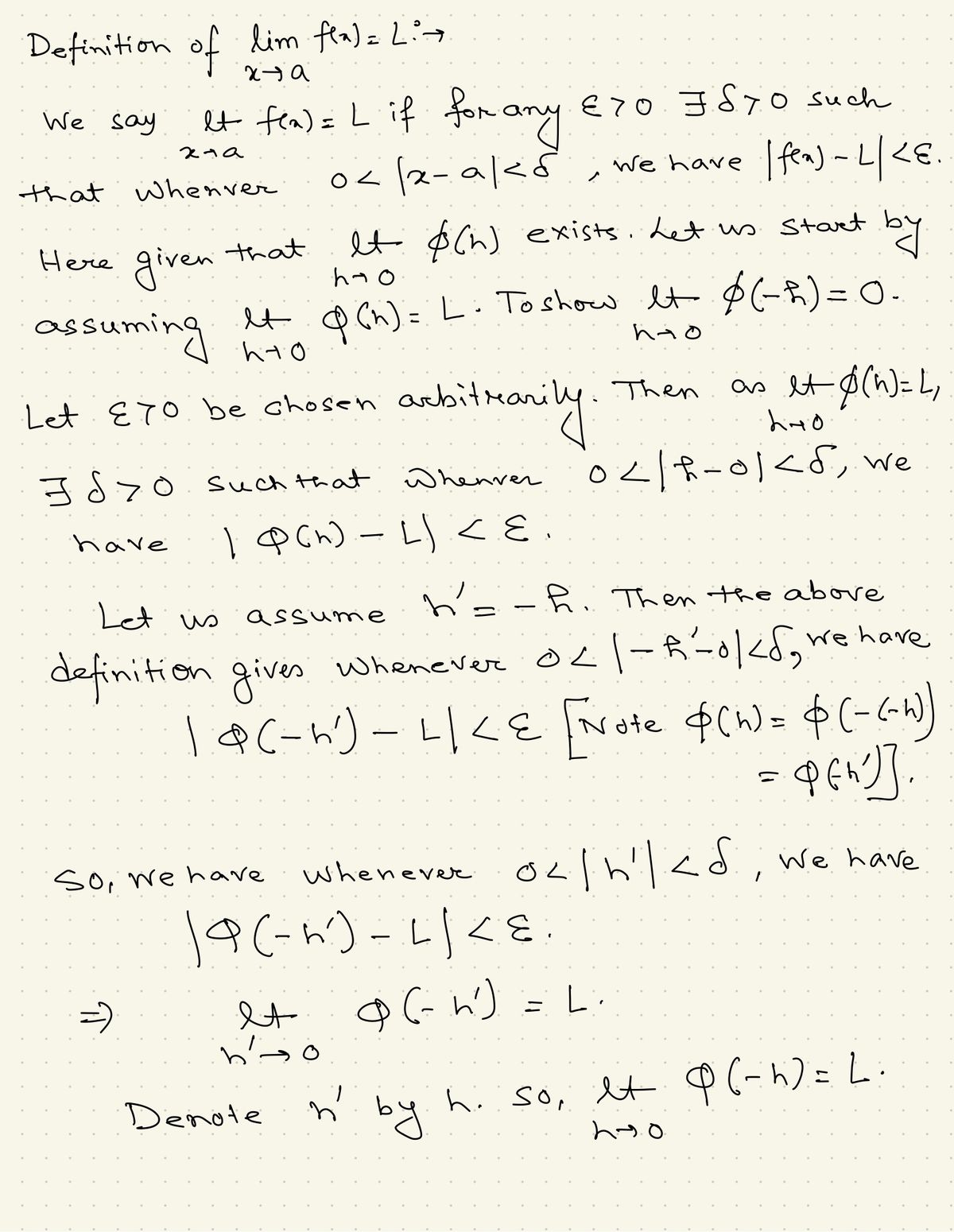Assume that limh-0 (h) exists. Show that limh-04 (h) show that if f is differentiable at a then There are two parts: f'(x) = lim h→0 f (x + h) − f (x − h) 2h = lim-0 (-h). Use this to
Assume that limh-0 (h) exists. Show that limh-04 (h) show that if f is differentiable at a then There are two parts: f'(x) = lim h→0 f (x + h) − f (x − h) 2h = lim-0 (-h). Use this to
Advanced Engineering Mathematics
10th Edition
ISBN:9780470458365
Author:Erwin Kreyszig
Publisher:Erwin Kreyszig
Chapter2: Second-order Linear Odes
Section: Chapter Questions
Problem 1RQ
Related questions
Question
Please answer both parts clearly. It's a practice question, and include a picture of your solution
![**Transcription for Educational Website**
---
**Theorem Proof and Differentiation**
Assume that \(\lim_{h \to 0} \varphi(h)\) exists. Show that \(\lim_{h \to 0} \varphi(h) = \lim_{h \to 0} \varphi(-h)\). Use this to show that if \(f\) is differentiable at \(x\) then
\[
f'(x) = \lim_{h \to 0} \frac{f(x + h) - f(x - h)}{2h}.
\]
**There are two parts:**
1. **Assume that \(\lim_{h \to 0} \varphi(h) = L\)**. Argue that for any \(\epsilon > 0\), there is a \(\delta > 0\) such that
\[
|\varphi(h) - L| < \epsilon \quad \text{whenever} \quad 0 < |h - 0| < \delta.
\]
2. **Change the variable \(h' = -h\) to prove that**
\[
\lim_{h' \to 0} \varphi(-h') = L.
\]
**Consider** \(\varphi(h) = \frac{f(x+h) - f(x)}{h}\), \(h \neq 0\). Notice that \(f'(x) = \lim_{h \to 0} \varphi(h)\). Use this and the first part to show that
\[
f'(x) = \frac{1}{2} \left( \lim_{h \to 0} \varphi(h) + \lim_{h \to 0} \varphi(-h) \right) = \lim_{h \to 0} \frac{f(x + h) - f(x - h)}{2h}.
\]
---
**Explanation of Diagrams/Graphs:**
There are no diagrams or graphs present in the provided text. This content is purely mathematical and textual in nature, focusing on proving a theorem related to limits and differentiability.](/v2/_next/image?url=https%3A%2F%2Fcontent.bartleby.com%2Fqna-images%2Fquestion%2Fa8d46346-fe9f-45aa-a3a0-df12b7cae379%2Fa0ab4aba-fe5a-4d8d-8734-1e4d963a3e2f%2Fw85kq3k_processed.png&w=3840&q=75)
Transcribed Image Text:**Transcription for Educational Website**
---
**Theorem Proof and Differentiation**
Assume that \(\lim_{h \to 0} \varphi(h)\) exists. Show that \(\lim_{h \to 0} \varphi(h) = \lim_{h \to 0} \varphi(-h)\). Use this to show that if \(f\) is differentiable at \(x\) then
\[
f'(x) = \lim_{h \to 0} \frac{f(x + h) - f(x - h)}{2h}.
\]
**There are two parts:**
1. **Assume that \(\lim_{h \to 0} \varphi(h) = L\)**. Argue that for any \(\epsilon > 0\), there is a \(\delta > 0\) such that
\[
|\varphi(h) - L| < \epsilon \quad \text{whenever} \quad 0 < |h - 0| < \delta.
\]
2. **Change the variable \(h' = -h\) to prove that**
\[
\lim_{h' \to 0} \varphi(-h') = L.
\]
**Consider** \(\varphi(h) = \frac{f(x+h) - f(x)}{h}\), \(h \neq 0\). Notice that \(f'(x) = \lim_{h \to 0} \varphi(h)\). Use this and the first part to show that
\[
f'(x) = \frac{1}{2} \left( \lim_{h \to 0} \varphi(h) + \lim_{h \to 0} \varphi(-h) \right) = \lim_{h \to 0} \frac{f(x + h) - f(x - h)}{2h}.
\]
---
**Explanation of Diagrams/Graphs:**
There are no diagrams or graphs present in the provided text. This content is purely mathematical and textual in nature, focusing on proving a theorem related to limits and differentiability.
Expert Solution
Step 1: Solution of the first part

Step by step
Solved in 3 steps with 2 images

Recommended textbooks for you

Advanced Engineering Mathematics
Advanced Math
ISBN:
9780470458365
Author:
Erwin Kreyszig
Publisher:
Wiley, John & Sons, Incorporated

Numerical Methods for Engineers
Advanced Math
ISBN:
9780073397924
Author:
Steven C. Chapra Dr., Raymond P. Canale
Publisher:
McGraw-Hill Education

Introductory Mathematics for Engineering Applicat…
Advanced Math
ISBN:
9781118141809
Author:
Nathan Klingbeil
Publisher:
WILEY

Advanced Engineering Mathematics
Advanced Math
ISBN:
9780470458365
Author:
Erwin Kreyszig
Publisher:
Wiley, John & Sons, Incorporated

Numerical Methods for Engineers
Advanced Math
ISBN:
9780073397924
Author:
Steven C. Chapra Dr., Raymond P. Canale
Publisher:
McGraw-Hill Education

Introductory Mathematics for Engineering Applicat…
Advanced Math
ISBN:
9781118141809
Author:
Nathan Klingbeil
Publisher:
WILEY

Mathematics For Machine Technology
Advanced Math
ISBN:
9781337798310
Author:
Peterson, John.
Publisher:
Cengage Learning,

